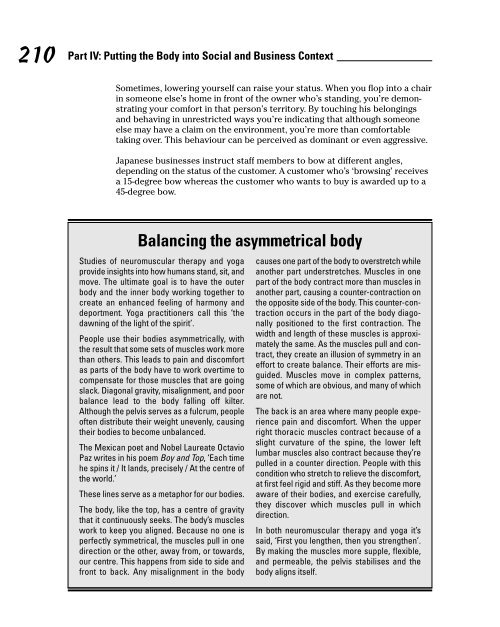Reading Body Language
Reading Body Language
Reading Body Language
Create successful ePaper yourself
Turn your PDF publications into a flip-book with our unique Google optimized e-Paper software.
210<br />
Part IV: Putting the <strong>Body</strong> into Social and Business Context<br />
Sometimes, lowering yourself can raise your status. When you flop into a chair<br />
in someone else’s home in front of the owner who’s standing, you’re demonstrating<br />
your comfort in that person’s territory. By touching his belongings<br />
and behaving in unrestricted ways you’re indicating that although someone<br />
else may have a claim on the environment, you’re more than comfortable<br />
taking over. This behaviour can be perceived as dominant or even aggressive.<br />
Japanese businesses instruct staff members to bow at different angles,<br />
depending on the status of the customer. A customer who’s ‘browsing’ receives<br />
a 15-degree bow whereas the customer who wants to buy is awarded up to a<br />
45-degree bow.<br />
Balancing the asymmetrical body<br />
Studies of neuromuscular therapy and yoga<br />
provide insights into how humans stand, sit, and<br />
move. The ultimate goal is to have the outer<br />
body and the inner body working together to<br />
create an enhanced feeling of harmony and<br />
deportment. Yoga practitioners call this ‘the<br />
dawning of the light of the spirit’.<br />
People use their bodies asymmetrically, with<br />
the result that some sets of muscles work more<br />
than others. This leads to pain and discomfort<br />
as parts of the body have to work overtime to<br />
compensate for those muscles that are going<br />
slack. Diagonal gravity, misalignment, and poor<br />
balance lead to the body falling off kilter.<br />
Although the pelvis serves as a fulcrum, people<br />
often distribute their weight unevenly, causing<br />
their bodies to become unbalanced.<br />
The Mexican poet and Nobel Laureate Octavio<br />
Paz writes in his poem Boy and Top, ‘Each time<br />
he spins it / It lands, precisely / At the centre of<br />
the world.’<br />
These lines serve as a metaphor for our bodies.<br />
The body, like the top, has a centre of gravity<br />
that it continuously seeks. The body’s muscles<br />
work to keep you aligned. Because no one is<br />
perfectly symmetrical, the muscles pull in one<br />
direction or the other, away from, or towards,<br />
our centre. This happens from side to side and<br />
front to back. Any misalignment in the body<br />
causes one part of the body to overstretch while<br />
another part understretches. Muscles in one<br />
part of the body contract more than muscles in<br />
another part, causing a counter-contraction on<br />
the opposite side of the body. This counter-contraction<br />
occurs in the part of the body diagonally<br />
positioned to the first contraction. The<br />
width and length of these muscles is approximately<br />
the same. As the muscles pull and contract,<br />
they create an illusion of symmetry in an<br />
effort to create balance. Their efforts are misguided.<br />
Muscles move in complex patterns,<br />
some of which are obvious, and many of which<br />
are not.<br />
The back is an area where many people experience<br />
pain and discomfort. When the upper<br />
right thoracic muscles contract because of a<br />
slight curvature of the spine, the lower left<br />
lumbar muscles also contract because they’re<br />
pulled in a counter direction. People with this<br />
condition who stretch to relieve the discomfort,<br />
at first feel rigid and stiff. As they become more<br />
aware of their bodies, and exercise carefully,<br />
they discover which muscles pull in which<br />
direction.<br />
In both neuromuscular therapy and yoga it’s<br />
said, ‘First you lengthen, then you strengthen’.<br />
By making the muscles more supple, flexible,<br />
and permeable, the pelvis stabilises and the<br />
body aligns itself.


